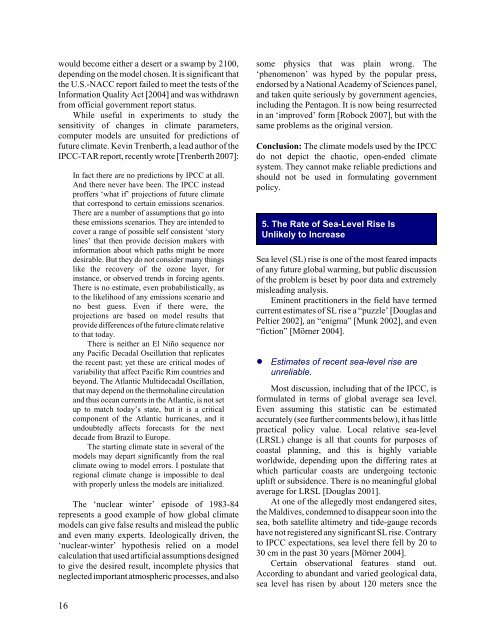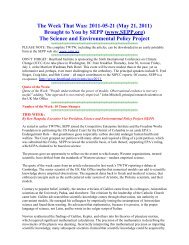Nature, Not Human Activity, Rules the Climate - Science ...
Nature, Not Human Activity, Rules the Climate - Science ...
Nature, Not Human Activity, Rules the Climate - Science ...
Create successful ePaper yourself
Turn your PDF publications into a flip-book with our unique Google optimized e-Paper software.
would become ei<strong>the</strong>r a desert or a swamp by 2100,depending on <strong>the</strong> model chosen. It is significant that<strong>the</strong> U.S.-NACC report failed to meet <strong>the</strong> tests of <strong>the</strong>Information Quality Act [2004] and was withdrawnfrom official government report status.While useful in experiments to study <strong>the</strong>sensitivity of changes in climate parameters,computer models are unsuited for predictions offuture climate. Kevin Trenberth, a lead author of <strong>the</strong>IPCC-TAR report, recently wrote [Trenberth 2007]:In fact <strong>the</strong>re are no predictions by IPCC at all.And <strong>the</strong>re never have been. The IPCC insteadproffers ‘what if’ projections of future climatethat correspond to certain emissions scenarios.There are a number of assumptions that go into<strong>the</strong>se emissions scenarios. They are intended tocover a range of possible self consistent ‘storylines’ that <strong>the</strong>n provide decision makers withinformation about which paths might be moredesirable. But <strong>the</strong>y do not consider many thingslike <strong>the</strong> recovery of <strong>the</strong> ozone layer, forinstance, or observed trends in forcing agents.There is no estimate, even probabilistically, asto <strong>the</strong> likelihood of any emissions scenario andno best guess. Even if <strong>the</strong>re were, <strong>the</strong>projections are based on model results thatprovide differences of <strong>the</strong> future climate relativeto that today.There is nei<strong>the</strong>r an El Niño sequence norany Pacific Decadal Oscillation that replicates<strong>the</strong> recent past; yet <strong>the</strong>se are critical modes ofvariability that affect Pacific Rim countries andbeyond. The Atlantic Multidecadal Oscillation,that may depend on <strong>the</strong> <strong>the</strong>rmohaline circulationand thus ocean currents in <strong>the</strong> Atlantic, is not setup to match today’s state, but it is a criticalcomponent of <strong>the</strong> Atlantic hurricanes, and itundoubtedly affects forecasts for <strong>the</strong> nextdecade from Brazil to Europe.The starting climate state in several of <strong>the</strong>models may depart significantly from <strong>the</strong> realclimate owing to model errors. I postulate thatregional climate change is impossible to dealwith properly unless <strong>the</strong> models are initialized.The ‘nuclear winter’ episode of 1983-84represents a good example of how global climatemodels can give false results and mislead <strong>the</strong> publicand even many experts. Ideologically driven, <strong>the</strong>‘nuclear-winter’ hypo<strong>the</strong>sis relied on a modelcalculation that used artificial assumptions designedto give <strong>the</strong> desired result, incomplete physics thatneglected important atmospheric processes, and alsosome physics that was plain wrong. The‘phenomenon’ was hyped by <strong>the</strong> popular press,endorsed by a National Academy of <strong>Science</strong>s panel,and taken quite seriously by government agencies,including <strong>the</strong> Pentagon. It is now being resurrectedin an ‘improved’ form [Robock 2007], but with <strong>the</strong>same problems as <strong>the</strong> original version.Conclusion: The climate models used by <strong>the</strong> IPCCdo not depict <strong>the</strong> chaotic, open-ended climatesystem. They cannot make reliable predictions andshould not be used in formulating governmentpolicy.5. The Rate of Sea-Level Rise IsUnlikely to IncreaseSea level (SL) rise is one of <strong>the</strong> most feared impactsof any future global warming, but public discussionof <strong>the</strong> problem is beset by poor data and extremelymisleading analysis.Eminent practitioners in <strong>the</strong> field have termedcurrent estimates of SL rise a “puzzle’ [Douglas andPeltier 2002], an “enigma” [Munk 2002], and even“fiction” [Mörner 2004].! Estimates of recent sea-level rise areunreliable.Most discussion, including that of <strong>the</strong> IPCC, isformulated in terms of global average sea level.Even assuming this statistic can be estimatedaccurately (see fur<strong>the</strong>r comments below), it has littlepractical policy value. Local relative sea-level(LRSL) change is all that counts for purposes ofcoastal planning, and this is highly variableworldwide, depending upon <strong>the</strong> differing rates atwhich particular coasts are undergoing tectonicuplift or subsidence. There is no meaningful globalaverage for LRSL [Douglas 2001].At one of <strong>the</strong> allegedly most endangered sites,<strong>the</strong> Maldives, condemned to disappear soon into <strong>the</strong>sea, both satellite altimetry and tide-gauge recordshave not registered any significant SL rise. Contraryto IPCC expectations, sea level <strong>the</strong>re fell by 20 to30 cm in <strong>the</strong> past 30 years [Mörner 2004].Certain observational features stand out.According to abundant and varied geological data,sea level has risen by about 120 meters snce <strong>the</strong>16





